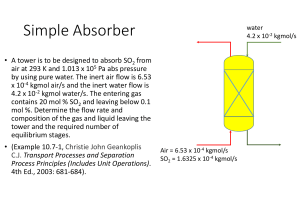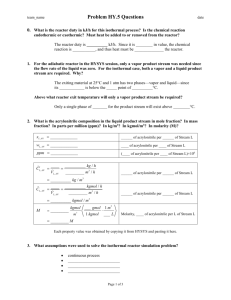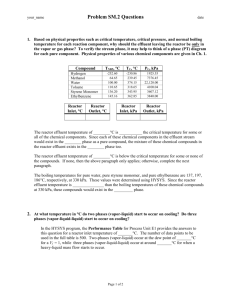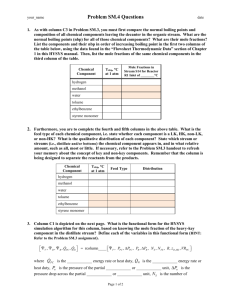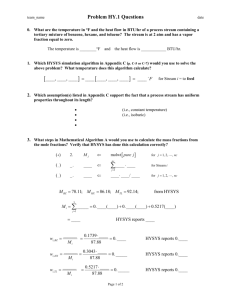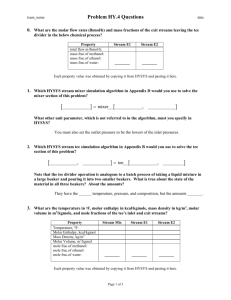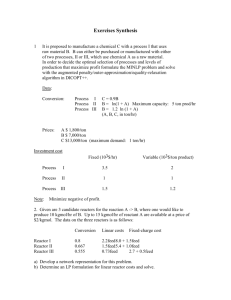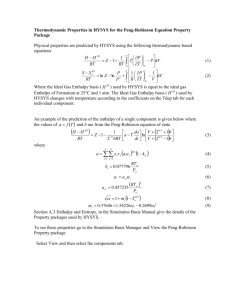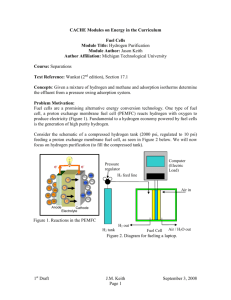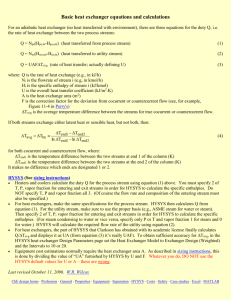Click here
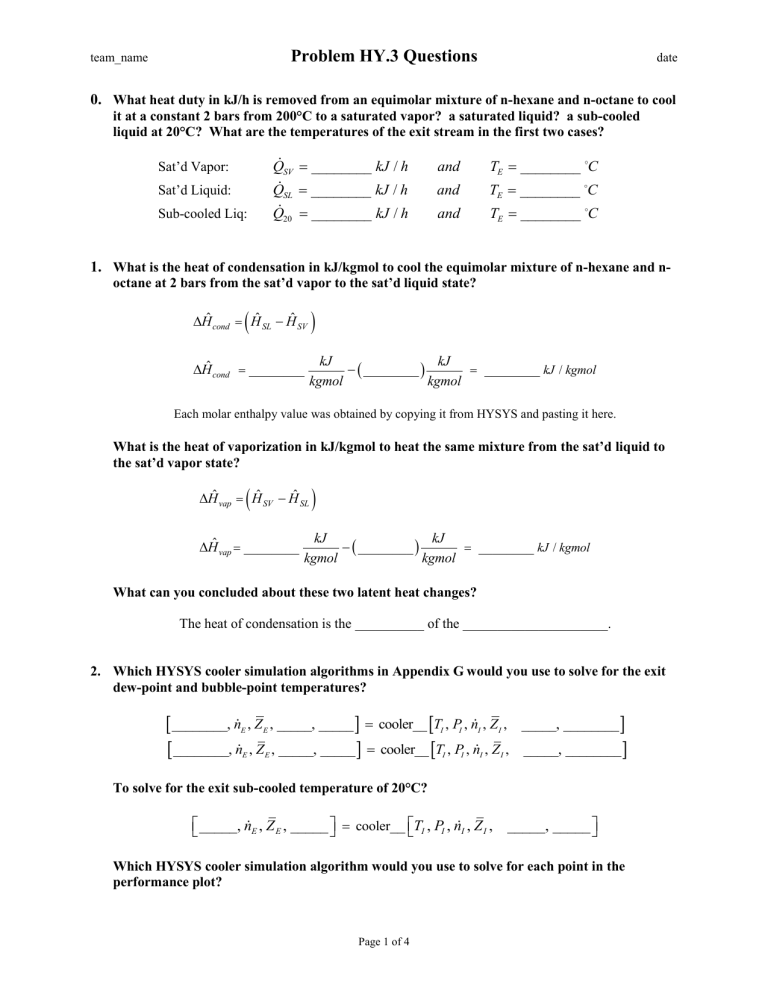
team_name
Problem HY.3 Questions date
0. What heat duty in kJ/h is removed from an equimolar mixture of n-hexane and n-octane to cool it at a constant 2 bars from 200°C to a saturated vapor? a saturated liquid? a sub-cooled liquid at 20°C? What are the temperatures of the exit stream in the first two cases?
Sat’d Vapor: Q
SV
________ / and T
E
________ C
Sat’d Liquid: Q
SL
________ / and T
E
________ C
Sub-cooled Liq: Q
20
________ / and T
E
________ C
1.
What is the heat of condensation in kJ/kgmol to cool the equimolar mixture of n-hexane and noctane at 2 bars from the sat’d vapor to the sat’d liquid state?
cond
ˆ ˆ
SL
SV
H cond
________ kJ kgmol
________
kJ kgmol
________
Each molar enthalpy value was obtained by copying it from HYSYS and pasting it here.
What is the heat of vaporization in kJ/kgmol to heat the same mixture from the sat’d liquid to the sat’d vapor state?
vap
SV
SL
vap
kJ
________ kgmol
________
kJ kgmol
________
What can you concluded about these two latent heat changes?
The heat of condensation is the __________ of the _____________________.
2.
Which HYSYS cooler simulation algorithms in Appendix G would you use to solve for the exit dew-point and bubble-point temperatures?
________, n
E
, Z
E
, _____, _____
cooler__
T P n Z
I I I
,
I
, _____, ________
________, n
E
, Z
E
, _____, _____
cooler__
T P n Z
I I I
,
I
, _____, ________
To solve for the exit sub-cooled temperature of 20°C?
_____, n
E
, Z
E
, _____
cooler __
T P n Z
I I I
,
I
, _____, _____
Which HYSYS cooler simulation algorithm would you use to solve for each point in the performance plot?
Page 1 of 4
team_name
Problem HY.3 Questions
_____, n
E
, Z
E
, _____
cooler __ ,
I
, ,
I
, _____, _____
3.
How do the mathematical models for the cooler and heater units in this problem differ?
Eq. __, the ______ balance, differs by the sign in front of the _______.
For the cooler, the sign is __. For the heater, the sign is __.
How are they the same?
Eqs. 1, 2, 4, 5, 6 are the ______ in the heater and cooler mathematical models. date
For the two conceptual diagrams above, what are their heat duties in kJ/h?
For the cooler, Q
___________ / , where energy is removed from the stream.
For the heater, Q
___________ / , where energy is added to the stream.
4.
The total specific energy of a process stream is composed of its internal energy, flow energy, kinetic energy, and potential energy. Note that enthalpy is defined to be internal energy plus flow energy (
ˆ
PV
ˆ
).
For the sub-cooled exit stream at 20°C, what additional information would you need to know in order to calculate its kinetic energy and potential energy?
E
K
E
P
_______
_______
need to know mass flow rate, velocity ( v ), acceleration of gravity, and height ( h ).
For a velocity of 1.6 m/s and a height of 10 m, what percentage of the total specific energy of the exit stream is internal energy, flow ( PV ) energy, kinetic energy, and potential energy?
T
E
P
E n
E
_______
_______ bar
_______
C m
V
ˆ
E
E
E
_________ /
_________ m
3
/ kgmol
_________ / from HYSYS from HYSYS from HYSYS
V
E
_________ m
3
/ h from HYSYS
P V
ˆ
E E
__ bar
_______ m
3 kgmol
1
___ kJ bar L
1000
1 m
3
L
__________ /
U
ˆ
E
E
ˆ
E
P V
ˆ
E E
__________
______
kg kgmol
E / n
E E
2
h
__________ / kg
___ m
2 s
2
h
_______ kgmol
2
/ s
3
kJ
1000 J
__________ /
P
E / n
P P
_______ h kg
_______ s 2 m
___ m
h
_______ kgmol
2 s
kJ
/ 3 1000 J
__________
Page 2 of 4
team_name
Problem HY.3 Questions date
Stream E abs( kJ/kgmol ) % of Total internal energy: flow energy: kinetic energy: potential energy:
%
%
%
%
% total energy
What would be the pipe diameter of the exit stream for a velocity of 1.6 m/s?
D
E
4
V
E
v
E
_____
0.5
4
cm
______
_____ in m
3 h
s
____ m
h
_____ s
0.5
________ m
3.2808
ft
12 in m ft using the continuity equation
5.
Which equations in the mathematical model would you use to calculate the molar enthalpy of the exit stream given the conditions of the inlet stream and the duty of the cooler? What is the exit stream molar enthalpy for a cooling operation using the inlet stream in this problem and a duty of 1000 kilo-watts? Check that HYSYS calculates the same result.
________________
hmix
T P Z
I
,
I
,
I
I
0
E
I
hmix 200 C , 2 bar , 0.5
HX
0.5
OC
____________
n
E
__________ /
45.36
kgmol h
________ kJ kgmol
_____ kW
1 kJ s
3600 s
1 h
1 kW
E
45.36
kgmol h
E
________ / HYSYS reports ________ /
6.
In your printed performance plot, label the dew-point temperature and bubble-point temperature on the temperature axis. After doing this task, you should notice three distinct areas on the plotted curve. Place a label on the liquid portion, vapor-liquid portion, and vapor portion of this plot.
Do this labeling on the next page using the cooling performance plot from 200°C to 20°C.
Page 3 of 4
team_name
Problem HY.3 Questions date
This plot of heat flow versus temperature is for a multicomponent mixture. What would the vapor-liquid portion of this plot look like, if the mixture contained only one chemical component (e.g., pure n-hexane)? What does the Gibbs Phase Rule state for the vapor-liquid portion?
The line connecting the bubble point to the dew point would be ____________.
Gibbs Phase Rule: dof = 2 + nc – Π = __ + __ – __ = __, ____ degree of freedom.
For a pure compound, the temperature remains _________ once the pressure is fixed.
7.
What is the energy relative imbalance ( %RIB
) for an exit temperature of 20°C? Show your calculations. The energy %RIB equals 100*(energy flow in – energy flow out) / (energy flow in).
% RIB
EB
% RIB
EB
___________
100
E in
_________ kJ/h
_________ kJ/h
_________ kJ/h
_________ kJ/h
100
_____ % RIB
EB
Each energy flow value was obtained by copying it from HYSYS and pasting it here.
In the HYSYS software, the Mass/Energy Balance page within the Flowsheet/Flowsheet Summary menu provides the relative imbalances for material and energy.
Page 4 of 4
